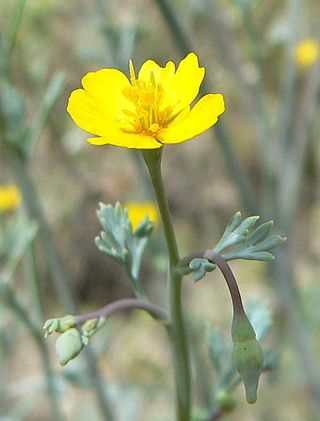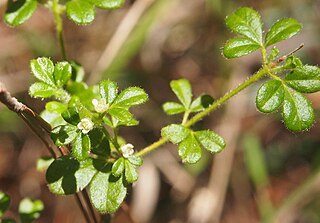
The Polemoniaceae are a family of flowering plants consisting of about 27 genera with 270–400 species of annuals and perennials native to the Northern Hemisphere and South America, with the center of diversity in western North America.

Gilia is a genus of flowering plants in the Polemoniaceae family and is related to phlox. It includes 39 species native to the Americas, ranging from British Columbia to Texas and northern Mexico, and to Ohio, in North America, and from Ecuador and Peru to southern Chile and Argentina in South America. These Western native plants are best sown in sunny, well-draining soil in the temperate and tropical regions of the Americas, where they occur mainly in desert or semi-desert habitats

Zieria is a genus of plants in the family, Rutaceae. About sixty species have been formally described, all of which are endemic to Australia except for one species which is found in New Caledonia. They occur in all Australian states except Western Australia but the genus is under review and a number of species are yet to be described or the description published. Zierias are similar to the better known genus Boronia but can be distinguished by the number of stamens in the flowers. The name Zieria honours the Polish botanist John Zier.
Clusia minutiflora is a species of flowering plant in the family Clusiaceae. It is found only in Ecuador. Its natural habitat is subtropical or tropical moist montane forest.
Garcinia minutiflora is a species of flowering plant in the family Clusiaceae. It is a tree endemic to Peninsular Malaysia.
Tristaniopsis minutiflora is a species of plant in the family Myrtaceae. It is endemic to New Caledonia.
Tylophora is a former genus of climbing plants or vines, first described as a genus in 1810. The genus was originally erected by Robert Brown for four species he described in Australia. It was synonymized with Vincetoxicum in 2018, a decision accepted by Plants of the World Online as of February 2023.

Imperata is a small but widespread genus of tropical and subtropical grasses, commonly known as satintails.

Villadia is a genus of plants in the family Crassulaceae. It includes about 25 to 30 species distributed from Texas to Peru.

Eschscholzia minutiflora is a species of poppy known by the common name pygmy poppy.

Melinis minutiflora, commonly known as molasses grass, is a species of grass.

Micromyrtus minutiflora is a species of flowering plant in the myrtle family and is endemic to New South Wales. It is a slender, spreading shrub with oblong to egg-shaped leaves and white flowers arranged singly in leaf axils.

Prunus minutiflora, called the Texas almond, is a shrub native to Texas and northern Mexico.

Vicia minutiflora, commonly known as pygmyflower vetch or smallflower vetch, is a species of plant in the legume family. It is native to the Southeastern United States, where it is most often found in dry, open woodlands.
Verticordia minutiflora is a flowering plant in the myrtle family, Myrtaceae and is endemic to the south-west of Western Australia. It is a bushy shrub with small, crowded, cylindrical leaves and groups of white to pale pink flowers in summer and autumn. As suggested by its botanical name, it has the smallest flowers of any verticordia.

Grevillea minutiflora is a species of flowering plant in the family Proteaceae and is endemic to the south-west of Western Australia. It is a shrub with many branches, tangled, divided leaves, the end lobes more or less linear, and cylindrical clusters of creamy-white flowers.

Zieria minutiflora, commonly known as twiggy zieria, is a plant in the citrus family Rutaceae and is endemic to eastern Australia. It is a small, erect, twiggy shrub with leaves composed of three leaflets, and clusters of small white flowers with four petals and four stamens. It usually grows as an understorey shrub in eucalypt woodland.
Goodenia minutiflora is a species of flowering plant in the family Goodeniaceae and is endemic to northern Australia. It is an annual herb with linear to lance-shaped leaves, and loose groups of tiny white or purplish flowers.
Ianhedgea is a monotypic genus of flowering plants belonging to the family Brassicaceae. The only species is Ianhedgea minutiflora.

Myosotis brevis is a species of flowering plant in the family Boraginaceae, endemic to New Zealand. George Simpson and J.S. Thomson described M. pygmaea var. minutiflora in 1942, and Peter de Lange and John Barkla recognized it at species rank in 2010, as M. brevis. Plants of this species of forget-me-not are small and annual, with a prostrate habit, bracteate inflorescences, tiny white corollas, and brown or green leaves.












